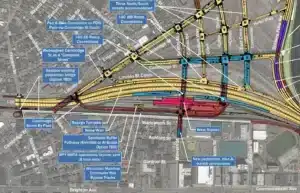
A schematic showing the current MassDOT proposal for the road layout in Harvard University's Allston mega-development. Image courtesy of MassDOT.
But at a meeting this week of high-level state and city leaders that included Gov. Maura Healey and Boston Mayor Michelle Wu, there were signs that elements of the project are still fluid, and state officials are racing to lock in federal funding amid concerns that the incoming Republican administration may try to punish the heavily Democratic Bay State.
Known as the Allston Multimodal Project, the proposal, in the works for more than a decade, is expected to cost hundreds of millions of dollars in federal and local funding. It includes replacing part of the Massachusetts Turnpike with an at-grade highway, a new commuter rail station on the Worcester/Framingham commuter rail line, new open space next to the Charles River, and bicycle and pedestrian connections.
One of the things Healey’s transportation chief, Monica Tibbits-Nutt, appeared to rule out earlier this year was a “layover yard” for trains, next to the proposed West Station on the Worcester/Framingham line. But in an emailed announcement just before Thanksgiving, Tibbits-Nutt ruled it back in, apparently without looping in neighborhood activists who had opposed the yard.
The activists had noted the tracks would take up five acres, valuable urban land next to a commuter rail station, with the Boston University campus and a future campus to be built by Harvard University nearby.
The train storage/layover yard, the activists said, was something that’s not needed, due to the MBTA’s purchase of Widett Circle in South Boston, close to South Station.
Activists are also concerned that diesel trains could end up idling in Allston, adding to air and noise pollution there and in neighboring Brighton. Both are considered “environmental justice” communities, home to many people of color who feel the effect of the highway slicing through the area. The Wu administration has allied with neighborhood activists.
Amtrak to Blame?
Amtrak seemed at least partly to blame, according to the Boston Globe, saying rail service between the eastern and western parts of Massachusetts, which would be run by the federal chartered corporation, was partly driving their interest in the tracks.
Rep. Michael Moran, a Brighton Democrat and a high-ranking House leader, was among the people unhappy with the latest changes. While he was given a heads up on the tweaks, other neighborhood activists found out about the decision after Fred Salvucci, a former state transportation chief, shared the pre-Thanksgiving email from Tibbits-Nutt.
That all led to a meeting this week at the State House, pulled together by Moran, and attended by Healey, Wu, Lt. Gov. Kim Driscoll, Tibbits-Nutt, state highway chief Jonathan Gulliver, and some of the unhappy activists. Moran didn’t respond to requests for comment, but other attendees or their spokespeople confirmed the meeting and offered some insight into what was discussed, which involved keeping the project moving and locking in federal funding as a Trump administration takes over.
If the meeting succeeded at anything, it was to bring the temperature down after some said the project had gone “off the rails,” according to attendees. The meeting also came after the Massachusetts Department of Transportation brought back a former highway department official, Luisa Paiewonsky, to run a new “Office of Megaproject Delivery” that is focused on Allston and the Cape Cod bridges, according to Contrarian Boston.
Speaking to reporters, Healey reiterated that the Allston project is a “huge economic development” opportunity.
“It’s a game-changer not just for that area and those neighborhoods but really for Massachusetts,” she said Tuesday. “And I think everyone is in agreement that this project’s got to go forward. Let’s get it done. In terms of some of the ideas around how do we best accommodate the trains that we need for the T, and what we need for Amtrak and commuter rail, that’s an ongoing discussion. We’re going to stay in dialogue with residents and the city about how best to do that.”
Tuesday Meeting May Have Helped
On the city side, Wu administration officials had previously expressed disappointment in the inclusion of the train layover yard, saying that it would, along with proposed “bypass” tracks, compromise new housing and the reconnection of the Allston neighborhood.
On Tuesday evening, a Wu spokesperson struck a more optimistic note: “We appreciate the governor’s and lieutenant governor’s leadership and the positive steps that the state and city are making together to secure federal funding and advance a project that delivers that full range of benefits,” she said.
City officials also want to get moving on more short-term, easier-to-tackle projects linked to the larger Allston multimodal plan that community leaders have pressed for, including the rebuild of a Cambridge Street overpass, a Franklin Street footbridge, and a long-requested addition of sound barriers along Lincoln Street and I-90.
The activists are also looking for more transparency, after feeling like a task force focused on the project was sidelined earlier this year, as expected meetings never occurred. Then came the changes in the aforementioned pre-Thanksgiving email from Tibbits-Nutt.
Stacy Thompson, a task force member and Allston multimodal project advocate, declined to rehash what meetings should’ve happened and hoped to see a meeting scheduled for early 2025 to keep the project on track.
“This is a messy moment, but I want to see a reset,” she said. “This is a moment to get things right in 2025.”
This article first appeared on CommonWealth Beacon and is republished here under a Creative Commons license.![]()






